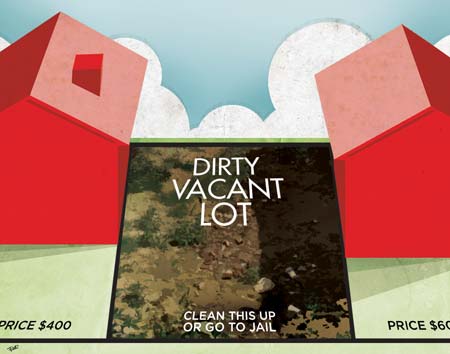Blight Fight: L&I prepares to hunt down absentee owners.

By Isaiah Thompson and Anthony Campisi
Tens of thousands of abandoned properties and vacant lots stretch across Philadelphia. Counts vary, but recent studies estimate at least 40,000 such properties, 75 percent of which belong to private owners — often delinquent on taxes and bills, often missing in action. In some cases, the owners might be dead or unwitting heirs. But others are slumlords and prospectors, whose game is to sit on these properties for as long as it takes to make a buck on them, while their properties attract crime, accumulate trash and fuel the spread of further blight.
For years, the city’s policy regarding these troubled spots could be summed up in two words: Fine ’em. Following a complaint, the Department of Licenses and Inspections (L&I) would send out an inspector, issue a fine and call it a day. A property could be fined dozens of times before the city took its owner to court. But under Commissioner Frances Burns, L&I cleared its 38,000-strong backlog of properties waiting inspection by instituing a radically simple policy: They now issue three fines, and then take an owner to court.
The result, Burns says, is energy and manpower for new projects — and starting in the next couple of weeks, the department intends to launch a pilot program aimed at rounding up and bringing to court absentee landlords. Now, Burns says, L&I is ready to begin actively seeking out absentee owners to either force them into compliance or bring them to court. The project is the first tangible result of a Nutter administration review of vacant lot policies, by the Managing Director’s and Finance Director’s offices. In the next few weeks, L&I officials will begin visiting 25,000 properties identified as vacant, one by one, and issuing appropriate violations.
The program will start in less-blighted areas on the city’s waterfront — a decision Councilwoman Maria Quiñones-Sánchez, parts of whose district are heavily blighted, found surprising — but which L&I officials characterize as a way to learn on the go.
At their disposal are a few tools, new or previously underutilized, to get at owners. There’s the “Doors and Windows Law,” a part of the city code that requires vacant properties on mostly occupied blocks to have functioning doors and windows — plywood doesn’t cut it. But probably the most innovative strategem L&I is employing is good old-fashioned gumshoeing. L&I director of strategic initiatives Maura Kennedy intends to systematically comb through various databases — including one used by the Internal Revenue Service — to determine ownership in cases where savvier owners hide behind corporate fronts. MORE
WHYY is your source for fact-based, in-depth journalism and information. As a nonprofit organization, we rely on financial support from readers like you. Please give today.






